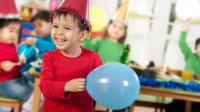Time-Tested Activities to Build Community in Elementary School
Strengthening community bonds in elementary school can start with simple ideas like celebrating personal and academic milestones.
Your content has been saved!
Go to My Saved Content.One of the first things I learned when I became a teacher was the importance of relationships. Getting to know the students and their families, cultures, interests, and problems creates a bond, and the students know their teacher cares about them. As a result, it becomes very important for most students to make sure that the teacher is satisfied with their efforts and improvement.
I’ve found over the years that there are several activities that help build relationships with second- and fourth-grade students. While these activities may not be new, together they offer ways to build a school family and foster community.
Activities That Build Community
Birthdays: Three years before Covid, we created the Birthday Crew, which included one student from each class in our grade level. We kept a list of every birthday, and when one came up—if the student celebrated birthdays (and not all of them do)—first thing in the morning the Birthday Crew gathered and decorated that student’s classroom door so that the student felt special as soon as they got to the room. Then the team went into the classroom, sang the birthday song, and threw confetti on the student.
We haven’t been able to do this grade-wide activity during the pandemic, but I’m hoping the time to start creating fun memories again is coming soon.
Cultural celebrations: I work with a teacher who calls the classroom her school family. Some years ago, we decided to start celebrating everything that we commemorate with our families with our class. My students still remember when we celebrated Thanksgiving together. We set out a big table with decorations and had our “dinner” with a turkey made out of popcorn, along with juice and fruit. We spent time as a family and gave thanks to each other.
Since that time the festivities have increased. When we came back from the winter break, we had a countdown and celebrated the New Year with hats, confetti, and noisemakers. We set the tone for a great beginning of a new year. This year I added a new celebration. Most of my students are from Mexico, and they celebrate Three Kings Day on January 6, so we had the traditional Rosca de Reyes. We had fun seeing who got the small toy babies in the sweet, wreath-shaped bread. It’s important that the students feel that their traditions are recognized in their schools.
The hot seat: With this activity, one of the students sits in a chair facing the class—the hot seat—and the other students go to the board and write something nice about the student in the chair. If they get stuck, I give them sentence stems such as “I like how you…,” “Thanks for…,” etc.
When everyone has written something, the student in the chair turns around and reads the messages. Then we take a picture and send it to their parents. This activity has transformed my students; one new student was very shy, and after this activity she realized that the others appreciated something about her and she became more confident. We try to find the time to have the hot seat at least once a week.
“I wish my teacher knew”: I saw this idea, based on a book, on social media. I give the students this prompt and they complete it. The kids know that this is a private activity. We use Seesaw, set as private so the students can’t see each other’s work. This is a way for teachers to learn not only about the happy moments in their students’ lives but also about the struggles they’re going through. Depending on the severity of the situation, the teacher can contact the counselor and the parents for support and to work together to do the best to help the student. We do this as a class every six weeks.
Celebrating growth: One of the most important books I’ve read is Mindset: The New Psychology of Success, which totally changed how I direct my class. My students know that what really matters is to try their best to learn and improve. We celebrate every time they make progress. We have a Growth Wall where students add a decorated little piece of paper with a handwritten note about their progress in one area that makes them proud. This has empowered my students to keep trying to increase their abilities and grow their knowledge at least a little every day—they know it doesn’t have to be perfect the first time. We try to do this every six weeks.
Teaching involves much more than academics. We become a family that spends most of the day together. The students need to feel safe, seen, supported, and celebrated so they can create fond memories of this time. These celebrations have helped us to be a family and a community.
